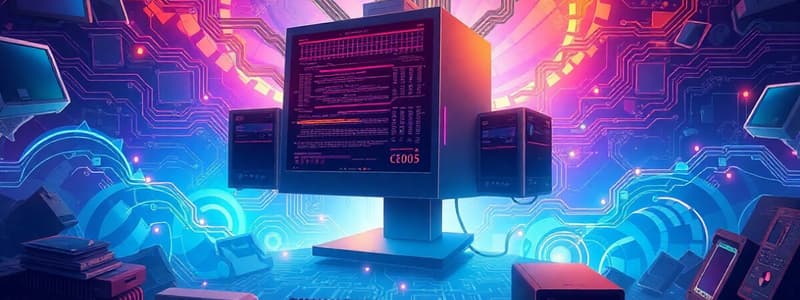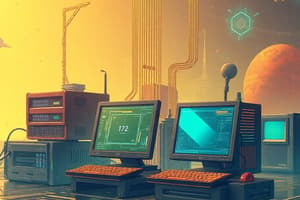Podcast
Questions and Answers
Which component of a computer is primarily responsible for processing data?
Which component of a computer is primarily responsible for processing data?
- Central Processing Unit (CPU) (correct)
- Input Device
- Memory (RAM)
- Storage Device
What characterizes the 3rd generation of computers?
What characterizes the 3rd generation of computers?
- Integrated Circuits (correct)
- Microprocessors
- Transistors
- Vacuum Tubes
Which of the following is classified as application software?
Which of the following is classified as application software?
- Linux
- Python
- Windows
- Microsoft Office (correct)
What is the main purpose of a firewall in computer security?
What is the main purpose of a firewall in computer security?
In which type of network are devices within a limited geographical area interconnected?
In which type of network are devices within a limited geographical area interconnected?
Flashcards are hidden until you start studying
Study Notes
Computer Fundamentals
- Input: Computers receive data or instructions.
- Processing: Computers perform calculations and operations on received data.
- Output: Computers produce results based on processing.
- Storage: Computers hold data and programs for future use.
Computer Components
- Central Processing Unit (CPU): The "brain" of the computer, responsible for processing instructions.
- Memory (RAM): Temporary storage for data and programs actively being used by the CPU.
- Storage Devices (HDD, SSD): Permanent storage for data and programs, allowing access even after the computer is turned off.
- Input Devices (Keyboard, Mouse): Allow users to provide input to the computer.
- Output Devices (Monitor, Printer): Display processed information or output from the computer.
Types of Computers
- Personal Computers (PCs): Designed for individual use.
- Laptops: Portable PCs with integrated displays and keyboards.
- Mobile Devices (Smartphones, Tablets): Compact devices with touchscreen interfaces, designed for portability and communication.
- Servers: Powerful computers that store and manage data and resources for a network.
- Mainframes: Large, powerful computers used by enterprises for high-volume data processing.
- Supercomputers: Highly specialized computers designed for complex calculations and simulations.
Computer Generations
- 1st Generation (1940s-1950s): Used vacuum tubes, large, expensive, and consumed a lot of energy.
- 2nd Generation (1950s-1960s): Used transistors, smaller, faster, and more energy-efficient than vacuum tubes.
- 3rd Generation (1960s-1970s): Used integrated circuits (ICs), further miniaturization and improved performance.
- 4th Generation (1970s-1980s): Used microprocessors, leading to the development of personal computers.
- 5th Generation (1980s-present): Focuses on artificial intelligence (AI), parallel processing, and advanced technologies.
Computer Software
- Operating Systems (Windows, macOS, Linux): Software that manages the computer's hardware and provides a user interface.
- Application Software (Microsoft Office, Google Docs): Software designed for specific tasks, such as word processing, spreadsheets, or browsing the internet.
- Programming Languages (Python, Java, C++): Used to create software applications and instruct computers.
Computer Hardware
- Motherboard: The main circuit board of the computer, connecting all components.
- Power Supply: Provides power to the computer and its components.
- Graphics Card: Handles graphical output, rendering images and videos.
- Sound Card: Processes and outputs audio.
- Network Card: Enables the computer to connect to a network.
Computer Network
- Local Area Network (LAN): Connects devices within a limited geographical area, such as a home or office.
- Wide Area Network (WAN): Connects devices over a large geographical area, often using public communication channels.
- Internet: A global network of interconnected computer networks.
- Wi-Fi: A wireless network technology that allows devices to connect to the internet or other networks without cables.
Computer Security
- Viruses: Malicious software programs that can damage or steal data.
- Malware: Any software designed to harm or disrupt computer systems.
- Firewalls: Security systems that protect computers from unauthorized access.
- Encryption: Transforms data into an unreadable format, protecting its confidentiality.
- Passwords: Secret codes used to authenticate users and prevent unauthorized access to accounts or systems.
Computer Applications
- Education: Computers are used for teaching, learning, and research.
- Business: Computers are used for management, communication, and data analysis.
- Healthcare: Computers are used for diagnosis, treatment, and research.
- Entertainment: Computers are used for gaming, media streaming, and online entertainment.
- Communication: Computers are used for email, instant messaging, and video conferencing.
Studying That Suits You
Use AI to generate personalized quizzes and flashcards to suit your learning preferences.




